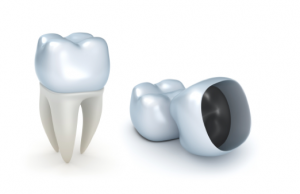A dental crown is a tooth-shaped “cap” that is placed over a tooth to repair a broken or badly damaged tooth. A crown restores a tooth’s shape, size, and strength. A dental crown differs from a dental veneer in that it covers more tooth structure because the tooth is more badly damaged, often by decay. Dental crowns can be made from a variety of materials, including metal, porcelain covered metal, or all-porcelain.
The procedure for installing a dental crown requires two dental office visits. During the first visit, the damaged tooth is prepared to receive the crown. If a large area of the tooth is missing due to decay, the tooth will be built up to support the crown. After the preparation, dental impressions will be made to send to a dental lab, where the permanent crown will be manufactured. A temporary crown will be fabricated to cover and protect the prepared tooth until the permanent crown is ready.
During the final visit, which is typically scheduled two weeks later, the temporary crown is removed and the permanent crown is seated. It is set in place with a dental adhesive or cement. The patient’s bite is checked for proper function and comfort. This visit is often much shorter and usually requires no anesthesia.


